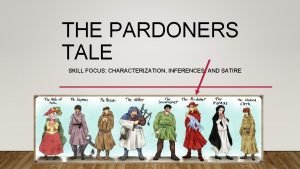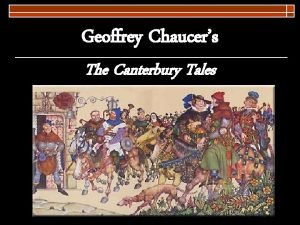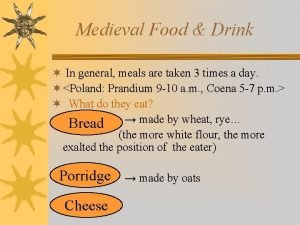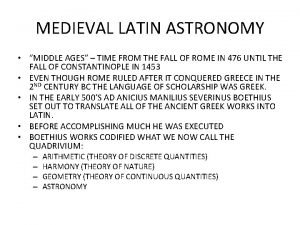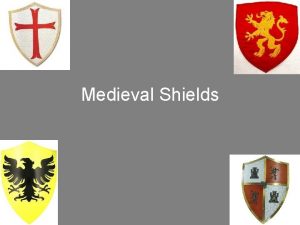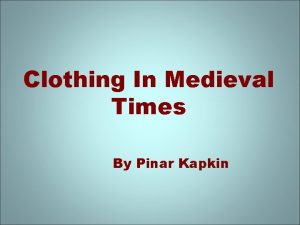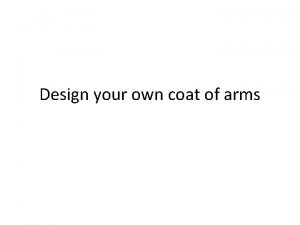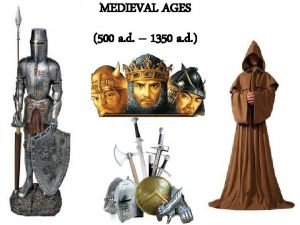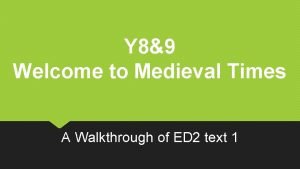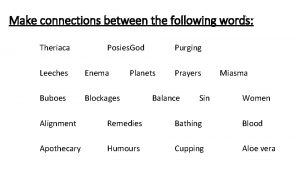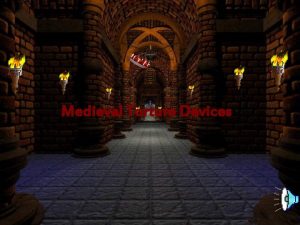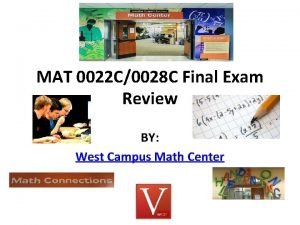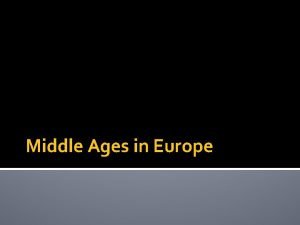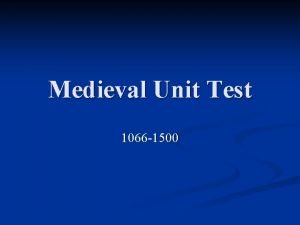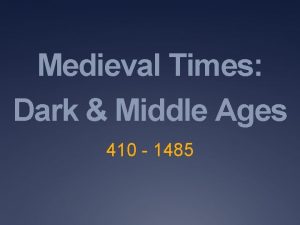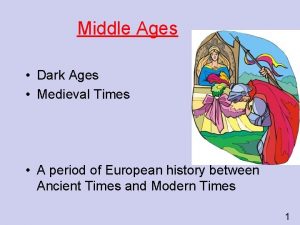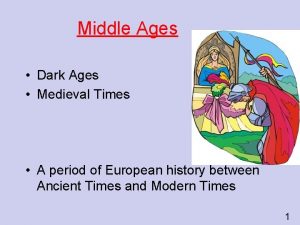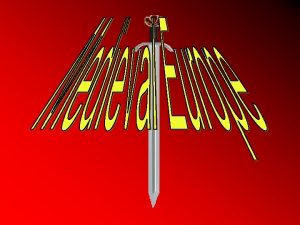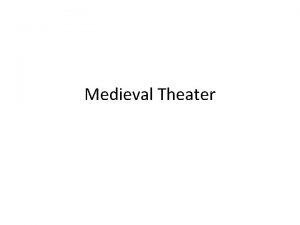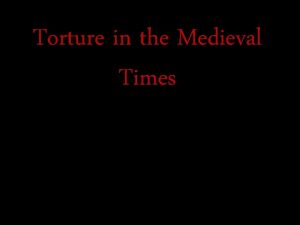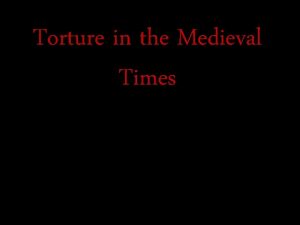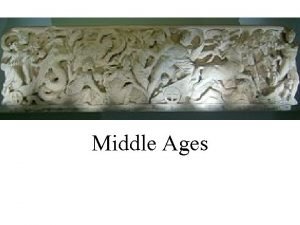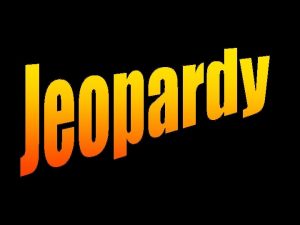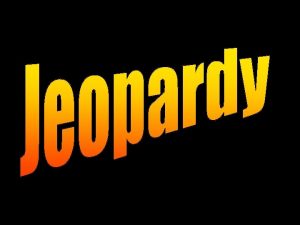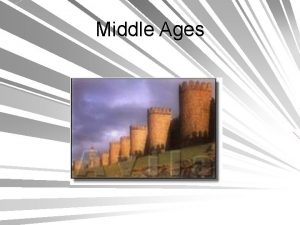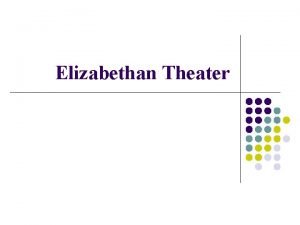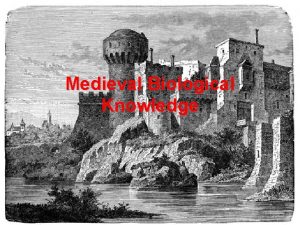MIDDLE AGES PRERENAISSANCE Middle Ages AKA medieval times


















- Slides: 18


MIDDLE AGES / PRE-RENAISSANCE Middle Ages (AKA medieval times) 500 AD/CE – 1500 AD/CE Civilization’s “mid-life crisis” – transition from ancient to modern AD 500 1000 1500 fall of Rome 2000 Renaissance Early Middle Ages (500 -1000 AD) known as the Dark Ages Best known for 1. feudalism 2. rise of the Catholic Church Feudalism – social system based on 1. birth 2. land 3. loyalty Most people lived on estates called manors Kings/lords Feudal contract – agreement between a lord (who gave land) and a vassal (who gave loyalty/service) Lesser lords Knights Peasants/serfs Development of chivalry (code of conduct for knights) 10% of Europe’s population were nobles/lords, 90% peasants/serfs Average life expectancy was 30 years – concern with afterlife Catholic Church survived the fall of Rome unifying element in Europe (one common factor) acted as the “go-between” for man and God determined salvation

What was required for salvation? Weekly/daily mass Attendance at Church 1. faith in God 2. good works sacraments tithing relics Required rituals (baptism, confession) 10% of income pledged to the Church Remains of saints, holy objects) Relationship of the Church to feudal lords/kings church provided blessing and support for the ruling classes lords/kings collected tithes, provided protection for the Church Later Middle Ages (1000 AD-1500 AD) Major events/changes 1. Crusades 2. town life 3. Magna Carta 4. Black Death 1096 -1204 Crusades (wars of the cross) main issue (cause) control of Holy Land/Jerusalem main result increased travel/trade between east, wes Town life population shift to towns/cities – trade opened up social mobility ( chance to move up in class) rise of the bourgeoisie 1. merchants 2. bankers 3. artisans/craftsmen 1215 1348 Magna Carta (Great Charter) – signed by England’s King John 3 essential ideas 1. even kings must follow the law 2. listing of individual rights 3. taxation must be fair The Black Death (bubonic plague) bacteria transmitted by flea bites Carried on trade ships by rats 20 -25 million killed – about 1/3 of Europe's population




The Renaissance (about 1350 -1650) 1. “rebirth” of classical ideas ( 2. remix of classical ideas into modern life What made the Renaissance possible? 1. Trade between Europe and the Middle East 2. Rise of the bourgeoisie 3. New ways to spread ideas Why did the Renaissance begin in Italy? 1. 2. 3. 4. What ideas were at the center of the Renaissance? Humanism Humanities )






Loved Feared Hated If you’re Machiavelli’s Prince, where do you want to be? Why? Rate the zones from 1 -5, 1 being the best, 5 the worst


RENAISSANCE ART AND ARTISTS DEMAND FOR ART CAME FROM: • the Catholic Church -- decoration of chapels and cathedrals; illustration of Bible stories and teachings • city-states -- display of civic pride • middle classes -- display of wealth; portraits for future generations NEW MEDIUMS AND TECHNIQUES PAINTING • change from watercolor and tempera to oil paints • perspective -- illusion of 3 -dimensional quality • chiaroscuro -- use of “lighting” effects SCULPTURE • return to “free-standing” statues • larger scales of sculpture and architecture WOODCUT PRINTS and ETCHINGS • allowed fine art to be mass-produced SUBJECTS/THEMES of RENAISSANCE ART RELIGION -- interpretations of Bible stories Madonnas -- images of Mary, mother of Jesus Pieta (Pity) -- images of the death of Christ saints and other religious figures HUMANISM -- Greco-Roman styles and stories allegories -- symbolic works portraits -- individual genre painting -- everyday life

RENAISSANCE ART CHECKLIST WORLD HISTORY -- Mr. Willis Name _______________ EARLY RENAISSANCE – most art was religious in nature and told stories Sandro Botticelli (1445 -1510) ___ The Birth of Venus, 1485 Donatello (1386 -1466) ___ St. George, 1417 ___ Gattamelata, 1448 ___ David, 1452 HIGH RENAISSANCE – more classical / humanist ideas, studio system developed, bigger scale Leonardo da Vinci (1452 -1519) ___ Mona Lisa (La Giaconda), 1504 ___ The Last Supper, 1500 ___ various notebook sketches Raphael (Raffaello Sanzio) (1483 -1520) ___ St. George and the Dragon, 1505 ___ La Belle Jardiniere, 1507 ___ The School of Athens. 1507 -1511 ___ Baldassare Castiglione, 1504 Michelangelo Buonaroti (1475 -1564) ___ Pieta, 1498 ___ David, 1504 ___ Sistine Chapel vault (ceiling), 1508 -1512 ___ Moses, 1513 ___ Medici family tomb, 1520 -1534 ___ The Last Judgment, 1536 -1541 ___ St. Peter’s Basilica dome, 1546 -1564 ___ The Deposition of Christ, 1550 -1555 NORTHERN RENAISSANCE – realistic portraits; very detailed; symbolism and social comment Jan van Eyck (1370? -1440) ___ The Arnolfini Wedding, 1434 Albrecht Durer (1473 -1528) ___ Self-portrait at 28, 1500 ___ A Young Hare (watercolor), 1502 ___ The Four Horsemen (woodcut), 1498 ___ The Bagpiper (woodcut), 1514 Rembrandt van Rijn (1606 -1668) ___ Philosopher in Meditation, 1632 ___ Self-portraits, 1630 s-1680 s ___ The Three Crosses (etchings), 1653 Pieter Breughel (the Elder) (1525 -1569) ___ The Peasant Wedding, 1567 ___ Hunters in the Snow, 1565 ___ The Beggars, 1548 Hieronymus Bosch (1450 -1516) ___ Death and the Miser, 1485? -1490? ___ The Ship of Fools, 1490? -1500? ___ The Last Judgment, 1500 s


 Why are the middle ages called the dark ages
Why are the middle ages called the dark ages Renaissance vs medieval art
Renaissance vs medieval art Satire in the pardoner’s tale quiz
Satire in the pardoner’s tale quiz Irony in the pardoner's tale
Irony in the pardoner's tale Medieval times drink menu
Medieval times drink menu Astronomy in medieval times
Astronomy in medieval times Medieval shield designs
Medieval shield designs Medieval merchant clothing
Medieval merchant clothing Create your own coat of arms
Create your own coat of arms Medieval times commercial
Medieval times commercial Medieval times walkthrough
Medieval times walkthrough Posies disease
Posies disease Medieval restraint devices
Medieval restraint devices Medieval times translator
Medieval times translator Mat0022
Mat0022 Sacred music of the middle ages
Sacred music of the middle ages Manorialism def
Manorialism def Middle ages unit test answers
Middle ages unit test answers Early american period floral design
Early american period floral design


